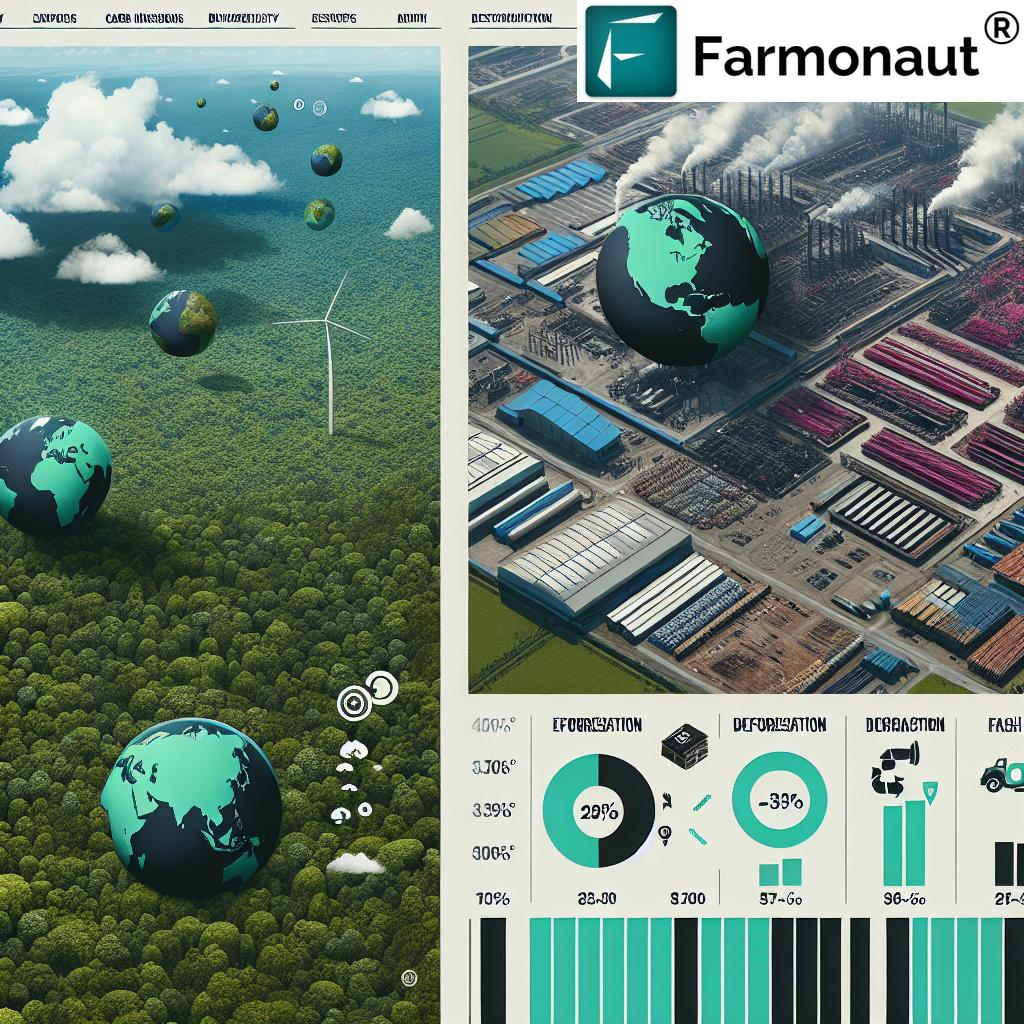Fashion’s Hidden Climate Impact: Uncovering Deforestation in Supply Chains and Sustainable Solutions

“The fashion industry contributes up to 10% of global carbon emissions, more than international flights and maritime shipping combined.”
In today’s world, the fashion industry stands at a critical crossroads. As we delve into the intricate web of sustainable fashion supply chains, we uncover a stark reality: the hidden climate impact of our clothing choices extends far beyond what meets the eye. The fashion sector, known for its glamour and innovation, harbors a less visible side – one that significantly contributes to global deforestation and carbon emissions.
We, as conscious consumers and industry professionals, must confront this challenge head-on. Our journey through this blog will explore how the production of clothing, from raw materials to finished products, plays a pivotal role in climate change and environmental degradation. We’ll unravel the complexities of deforestation in the fashion industry, examine the carbon emissions from clothing production, and investigate the potential for climate change mitigation in fashion.
The Hidden Toll: Deforestation and Fashion
“Approximately 150 million trees are logged annually to produce fabric for clothing, equivalent to one tennis court every second.”
The fashion industry’s impact on our forests is staggering. Each year, vast swathes of forest are cleared to make way for textile production. This deforestation not only destroys vital ecosystems but also releases significant amounts of stored carbon into the atmosphere, exacerbating climate change.
- Rayon and viscose production leads to the clearing of ancient and endangered forests
- Leather tanning processes contribute to deforestation in the Amazon
- Cotton cultivation often leads to land conversion and habitat loss
The demand for fast fashion has intensified these issues, with rapid production cycles leading to increased resource consumption and waste. As we strive for sustainable fashion supply chains, it’s crucial to address these hidden impacts and seek out more responsible alternatives.
Carbon Footprint of Fashion: A Closer Look
The fashion industry’s carbon footprint extends far beyond the manufacturing process. From the fields where fibers are grown to the factories where garments are sewn, and finally to the stores where they’re sold, each step in the supply chain contributes to the industry’s overall emissions.

Key factors contributing to fashion’s carbon emissions include:
- Agricultural practices for natural fibers
- Production of synthetic materials
- Energy-intensive manufacturing processes
- Global transportation and logistics
- Retail operations and packaging
To truly understand and address the industry’s impact, we need comprehensive carbon accounting in the fashion industry. This involves not only measuring direct emissions from production facilities but also accounting for indirect emissions throughout the supply chain, including those from land-use changes due to deforestation.
Forest-Friendly Textile Materials: A Path Forward
As we seek solutions to reduce fashion’s environmental impact, forest-friendly textile materials emerge as a promising avenue. These innovative fabrics aim to minimize deforestation while still meeting the industry’s needs for versatile and durable materials.
- Tencel: Made from sustainably harvested wood pulp
- Organic cotton: Grown without harmful pesticides or synthetic fertilizers
- Recycled polyester: Reduces demand for virgin petroleum-based materials
- Hemp: A fast-growing crop that requires minimal water and no pesticides
By embracing these alternatives, fashion brands can take significant steps towards reducing fashion’s environmental impact. However, the adoption of these materials must be paired with responsible sourcing practices to ensure their production doesn’t inadvertently contribute to deforestation elsewhere.
Challenges in Eco-Friendly Fabric Sourcing
While the concept of eco-friendly fabric sourcing is gaining traction, its implementation faces several hurdles:
- Limited availability of sustainable materials at scale
- Higher costs compared to conventional fabrics
- Complexity in verifying the sustainability claims of suppliers
- Balancing performance requirements with environmental considerations
Overcoming these challenges requires a concerted effort from all stakeholders in the fashion industry. Brands must invest in research and development, forge partnerships with innovative suppliers, and commit to long-term sustainability goals.
Sustainable Leather Alternatives: Innovation in Action
Leather production has long been associated with deforestation, particularly in regions like the Amazon. However, the rise of sustainable leather alternatives is offering new hope for reducing this impact:
- Mycelium leather: Made from mushroom roots
- Pineapple leather: Derived from pineapple leaf fibers
- Lab-grown leather: Produced through cellular agriculture
- Recycled leather: Created from leather waste
These innovative materials not only reduce the need for animal hides but also often require less water and energy to produce compared to traditional leather.
Carbon Accounting in Fashion: Measuring the True Impact
Carbon accounting in the fashion industry is a complex but essential process for understanding and mitigating the sector’s climate impact. It involves quantifying greenhouse gas (GHG) emissions across the entire value chain, from raw material extraction to end-of-life disposal.
Key components of fashion carbon accounting include:
- Scope 1 emissions: Direct emissions from owned or controlled sources
- Scope 2 emissions: Indirect emissions from purchased electricity, steam, heating, and cooling
- Scope 3 emissions: All other indirect emissions in a company’s value chain
Accurately calculating these emissions requires sophisticated methodologies and robust data collection systems. Many fashion brands are now partnering with technology companies to leverage advanced tools for more precise carbon footprint assessments.
For instance, companies like Farmonaut offer innovative solutions for tracking and managing environmental impacts. While primarily focused on agricultural applications, their expertise in satellite-based monitoring and AI-driven insights could potentially be adapted to assist fashion brands in assessing land use changes and deforestation risks in their supply chains. Learn more about Farmonaut’s capabilities through their API Developer Docs.
EU Deforestation Regulation: A Game-Changer for Fashion
The introduction of the EU deforestation regulation marks a significant milestone in the fight against deforestation in supply chains. This regulation aims to ensure that products sold in the EU market do not contribute to deforestation or forest degradation.
For the fashion industry, EU deforestation regulation compliance means:
- Implementing due diligence systems to trace the origin of raw materials
- Ensuring that products are “deforestation-free” before entering the EU market
- Providing detailed information on the sourcing of materials like leather and certain textiles
- Facing potential fines and market exclusion for non-compliance
This regulation is set to reshape global supply chains, pushing fashion brands to adopt more transparent and sustainable practices. It also highlights the growing importance of traceability in the fashion industry.
Rethinking Fashion Supply Chains for Sustainability
To truly address the hidden climate impacts of fashion, a fundamental rethinking of supply chains is necessary. This transformation involves:
- Adopting circular economy principles
- Investing in regenerative agriculture for natural fibers
- Implementing blockchain technology for enhanced traceability
- Collaborating with suppliers to reduce emissions throughout the value chain
- Embracing slow fashion and quality-over-quantity approaches
By reimagining supply chains, the fashion industry can not only reduce its environmental footprint but also create more resilient and ethical business models.
The Role of Technology in Sustainable Fashion
Technology plays a crucial role in driving sustainability in the fashion industry. From AI-powered design tools that reduce waste to blockchain systems that enhance supply chain transparency, innovative technologies are paving the way for a more sustainable future in fashion.
Key technological advancements include:
- 3D printing for on-demand production
- AI and machine learning for demand forecasting and inventory management
- IoT devices for real-time supply chain monitoring
- Digital passport systems for product traceability
These technologies not only help in reducing fashion’s environmental impact but also enable brands to make more informed decisions and improve their overall sustainability performance.
Consumer Awareness and Sustainable Choices
As we uncover the hidden climate impacts of fashion, consumer awareness and action become increasingly important. Educated consumers can drive significant change by:
- Choosing products made from sustainable materials
- Supporting brands with transparent and ethical supply chains
- Embracing secondhand and vintage fashion
- Practicing mindful consumption and extending the lifespan of garments
By making informed choices, consumers can send a powerful message to the industry, encouraging further investment in sustainable practices and innovations.
The Future of Sustainable Fashion: Trends and Predictions
As we look to the future, several trends are shaping the landscape of sustainable fashion:
- Increased adoption of regenerative farming practices for natural fibers
- Growth in bio-based and lab-grown materials
- Expansion of rental and resale markets
- Integration of digital technologies for virtual try-ons and customization
- Stricter regulations on environmental claims and greenwashing
These trends indicate a shift towards a more responsible and innovative fashion industry, one that prioritizes both style and sustainability.
Comparison Table: Fashion Industry’s Environmental Impact
| Fashion Industry Sector | Estimated Annual Deforestation Impact (hectares) | Estimated Carbon Emissions (tons CO2e) | Common Materials Used | Sustainable Alternatives | Compliance with EU Deforestation Regulation |
|---|---|---|---|---|---|
| Fast Fashion | 150,000 | 1,200,000 | Polyester, Cotton, Viscose | Recycled Polyester, Organic Cotton, Tencel | No |
| Luxury Fashion | 50,000 | 500,000 | Leather, Silk, Cashmere | Plant-based Leather, Peace Silk, Recycled Cashmere | Partial |
| Sustainable Brands | 10,000 | 100,000 | Organic Cotton, Hemp, Recycled Materials | Already using sustainable materials | Yes |
| Sportswear | 80,000 | 800,000 | Synthetic Fibers, Technical Fabrics | Recycled Polyester, Bio-based Synthetics | Partial |
This table provides a stark comparison of the environmental impact across different sectors of the fashion industry. It highlights the significant differences in deforestation rates and carbon emissions, emphasizing the urgent need for sustainable practices across all segments.
Practical Steps for Reducing Fashion’s Environmental Impact
While the challenges are significant, there are practical steps that both industry players and consumers can take to reduce fashion’s environmental impact:
For Brands:
- Invest in sustainable material innovation
- Implement comprehensive supply chain traceability systems
- Set science-based targets for emissions reduction
- Adopt circular design principles to minimize waste
- Engage in partnerships for collective action on sustainability
For Consumers:
- Prioritize quality over quantity in purchasing decisions
- Research brands’ sustainability credentials before buying
- Care for garments properly to extend their lifespan
- Participate in clothing rental or swapping initiatives
- Support policy measures that promote sustainable fashion
The Road Ahead: Challenges and Opportunities
As we confront the hidden climate impacts of fashion, we face both challenges and opportunities:
Challenges:
- Scaling sustainable materials production
- Addressing the higher costs associated with sustainable practices
- Changing consumer behaviors and expectations
- Navigating complex global supply chains
Opportunities:
- Driving innovation in materials and production processes
- Creating new business models centered on sustainability
- Enhancing brand value through genuine environmental commitments
- Contributing to global climate change mitigation efforts
By addressing these challenges and seizing the opportunities, the fashion industry can transform itself into a force for positive environmental change.
Conclusion: A Call to Action for Sustainable Fashion
As we conclude our exploration of fashion’s hidden climate impact, it’s clear that the path to sustainability in the industry is both necessary and complex. The challenges of deforestation, carbon emissions, and unsustainable supply chains require a concerted effort from all stakeholders – brands, suppliers, policymakers, and consumers alike.
We must embrace innovative solutions, from forest-friendly textiles to advanced carbon accounting methodologies. The EU deforestation regulation serves as a catalyst for change, pushing the industry towards greater transparency and responsibility. As we move forward, it’s crucial to remember that every choice – from the materials we use to the clothes we buy – has an impact on our planet.
By uncovering these hidden impacts and committing to sustainable solutions, we can transform the fashion industry into one that not only celebrates creativity and style but also respects and protects our environment. The journey towards truly sustainable fashion is long, but with collective action and innovation, it’s a goal within our reach.
Let’s commit to making informed choices, supporting sustainable practices, and advocating for a fashion industry that values both style and sustainability. Together, we can weave a future where fashion and environmental stewardship go hand in hand.
FAQs
- Q: How does the fashion industry contribute to deforestation?
A: The fashion industry contributes to deforestation through the production of materials like viscose and rayon, which often involve logging ancient forests. Additionally, leather production can lead to clearing land for cattle grazing, particularly in regions like the Amazon. - Q: What are some sustainable alternatives to traditional leather?
A: Sustainable leather alternatives include mycelium leather made from mushroom roots, pineapple leather derived from pineapple leaf fibers, lab-grown leather produced through cellular agriculture, and recycled leather created from leather waste. - Q: How can consumers make more sustainable fashion choices?
A: Consumers can make more sustainable fashion choices by choosing products made from eco-friendly materials, supporting brands with transparent and ethical supply chains, buying secondhand or vintage items, and extending the lifespan of their garments through proper care and repair. - Q: What is the EU deforestation regulation, and how does it affect the fashion industry?
A: The EU deforestation regulation aims to ensure that products sold in the EU market do not contribute to deforestation. For the fashion industry, this means implementing due diligence systems to trace the origin of raw materials and ensuring products are “deforestation-free” before entering the EU market. - Q: How can technology help in creating more sustainable fashion supply chains?
A: Technology can help create more sustainable fashion supply chains through AI-powered design tools that reduce waste, blockchain systems for enhanced supply chain transparency, 3D printing for on-demand production, and IoT devices for real-time supply chain monitoring.






